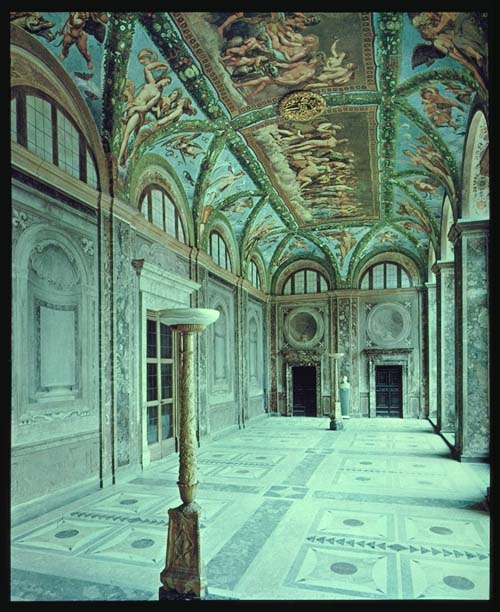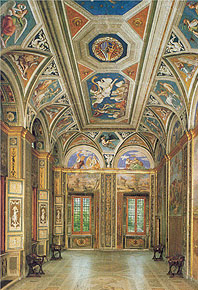|
|
 |
|
The Villa Farnesina |
|
written
by karadunn / 09.18.2004 |
|
|
| |
Description |
| |
| |

|
|
| Loggia della Eros e Psyche |
| The Loggia of Cupid and Psyche was designed by Raphael. Though much of the actual painting was done by his students, Raphael's own hand in evident in the lovely face of Psyche as she accends to Olympus with her lover, Cupid. While completing the loggia, Raphael was supposedly so sick wtih longing for his mistress that Chigi had her brought to stay at the villa in order to allow the artist to focus on his work. It is thought to be her face that Raphael used as a model for Psyche in this cycle of frescoes. |
| |
|
| |

|
|
| Hall of Galatea |
| The ceiling in the Hall of Galatea, designed and painted by Peruzzi, represents the alignment of the stars on the day of Agostino Chigi's birth. His horoscope supposedly foretold a long and prosperous life. |
| |
|
| |

|
|
| Triumph of Galatea |
| Raphael's "Galatea" depicts the beautiful sea nymph riding across the waves on her chariot as she laughs at the cyclops Polyphemus, who is singing her a love song (pictured elsewhere in the hall). |
| |
|
"Loggia della Psyche"
The Farnesina is set in the midst of a beautiful garden of bergamot trees, cedars from Lebanon, cypresses, laurel bushes, and evergreens. On the ground floor of the Villa, an entrance hall leads to the Loggia della Psyche. The frescoes there were painted by Raphael and his pupils Giulio Romano, Francesco Penni, Raffaellino del Colle, and Giovanni da Udine. Raphael was commissioned to decorate the loggia in 1517, five years after painting the Galatea there. Like the Galatea, this cycle reflects the cultured atmosphere which had flourished in Rome under Pope Julius II and Leo X. According to his commission, Raphael was to decorate the large entrance loggia. This is a space which communicates between the living room and the garden outside. Raphael approached the individual character of this space by treating the roofed structure, which is a part of the main building, as an open pergola. He divided the space with magnificent, rampant garlands of exotic fruits that had been recently discovered in the explorations of the Americas. In fact, the garlands, painted by da Udine, were so admired by Pope Leo X that he commissioned the painter to decorate the first floor of the loggia in the Vatican with similar floral motifs. In keeping with the theme of the loggia as a pergola, Raphael also designed two large ceiling pictures that simulate tapestries stretched across the room. These huge awnings were painted so that we can see the straps “holding” the tapestries in place, and even the scalloped edges they create by stretching the material.
The frescoes around the ceiling represent episodes from the story of Cupid and Psyche as told by Aduleius in the “Metamorphasis.” Some of the remarkable frescoes include Venus showing Cupid her rival, Psyche; Cupid talking to the Three Graces; Venus going to Olympus on her chariot pulled by doves; Psyche competing the tasks set to her by Venus; and finally the story ends with the two psuedo tapestries on the ceiling which show the Council and the Banquet of the Gods, during which the marriage between Cupid and Psyche is arranged and celebrated. Although the preparatory drawings and the general conception of the stories are certainly Raphael’s work, the bulk of the painting was actually carried out by his pupils.
"Hall of Galatea"
To the right of the loggia is the Hall of Galatea, which contains the famous fresco depicting the triumph of the nymph Galatea, on a shell pulled by dolphins. The subject is chosen from a poem by Angelo Poliziano, a poet from Florence, which had also helped inspire Botticelli’s Birth of Venus. These lines describe how the clumsy giant cyclops, Polyphemus, sings a love song to the beautiful sea-nymph Galatea, and how she rides across the waves in a chariot drawn by two dolphins, laughing at his song while a company of sea gods mills around her. In the myth, Galatea refuses Polyphemus' advances because of her love for a Sicilian youth named Acius. Polyphemus eventually kills Acius with a boulder in a jealous rage, and a distraught Galatea turns his blood into the river Acius in Sicily.
All around the fresco of Galatea are delicate and idealized landscapes painted by Gaspare Dughet, and higher up on the wall there is a stunning Head of a Young Man. The charcoal colored head set against a rough background was originally attributed to Michelangelo, but modern opinion is inclined to credit it to Peruzzi. The lunettes, representing several myths, and the wide square near Galatea where Polyphemus stands, are the work of Sebastinao del Piombo. The vaulted roof, which was painted by Peruzzi, represents the twelve signs of the zodiac with planetary gods residing in some of them. Venus, for example, appears with the sign of Capricorn, and Apollo, the sun, with the the Archer. Star-charts of the northern hemisphere show that the constellations in Peruzzi’s fresco would have occupied this position on December 1, 1466. Since there is no documentation accurately pinpointing the date of Chigi’s death, though it was thought to be around the year 1465, it is generally believed that this ceiling represents the position of the stars on the day of Chigi’s birth. Peruzzi, an astrologer, would certainly have been capable of painting a precise horoscope for Chigi, and Chigi himself was known to believe in astrology, perhaps because his stars foretold and long and prosperous life for him.
From the windows on the first floor, there is a beautiful view of the gardens. A pleasant stroll under the laurel bower leads to a marble plaque which bears the inscription:
"Quisquis huc accedes: quod tibi horridum videtur mihi amoenum est; si placet, maneas, si taedet abeas, utrumque gratum" which translates to:
"Whoever enters here: what seems horrid to you is pleasant to me. If you like it, stay, if it bores you, go away; both are equally pleasing to me."
|
| |
|
| |
|
|
 |
|



